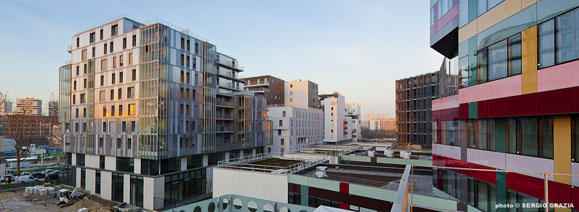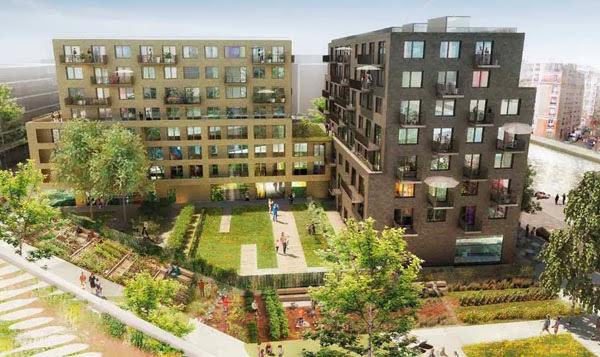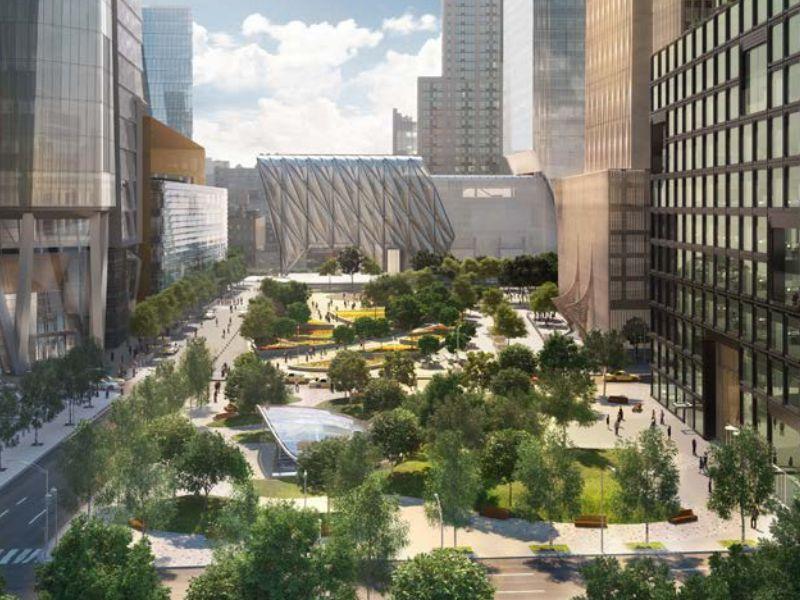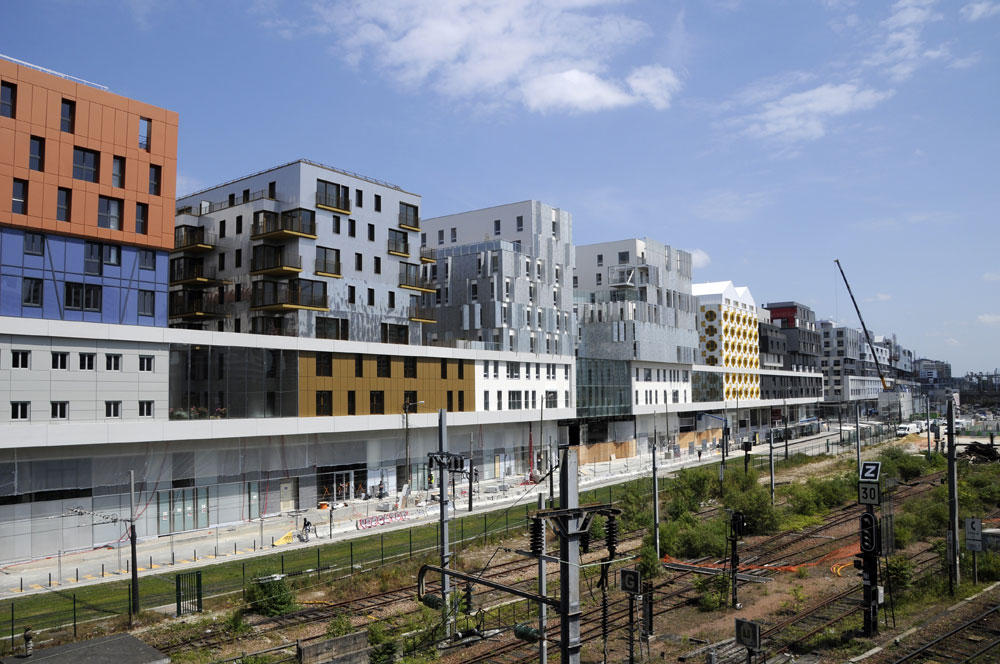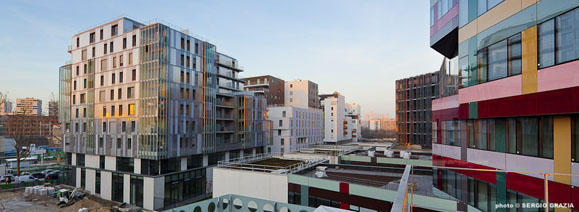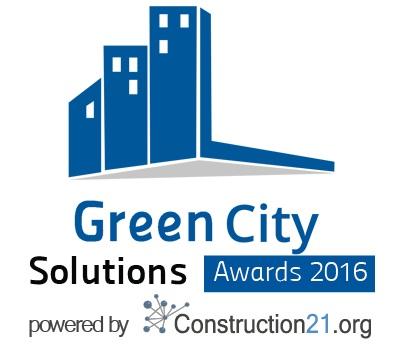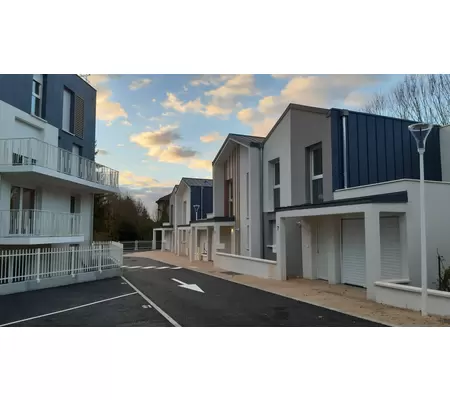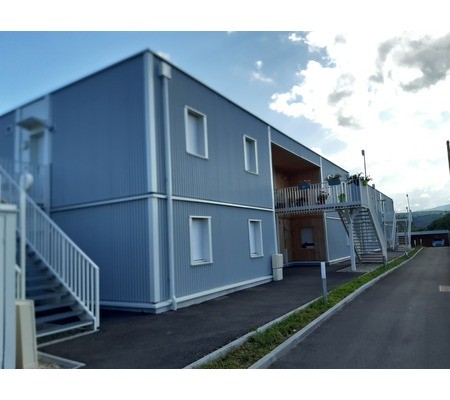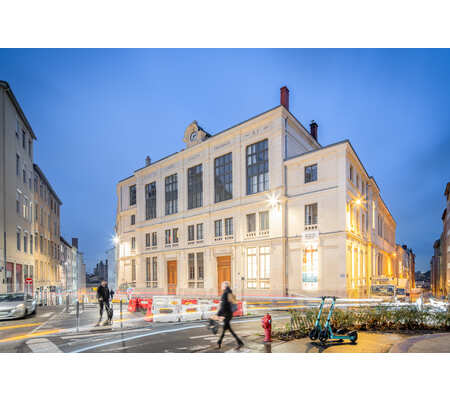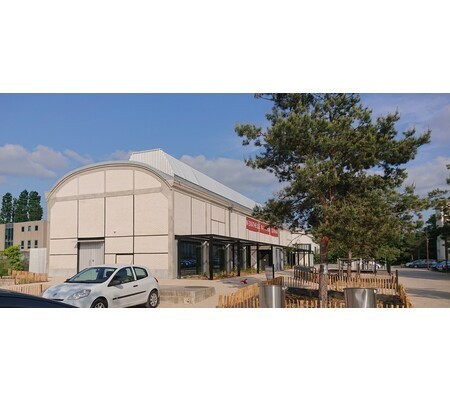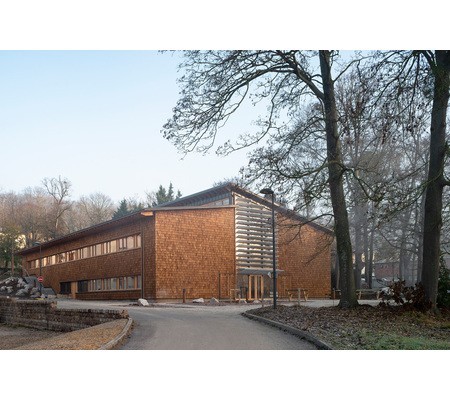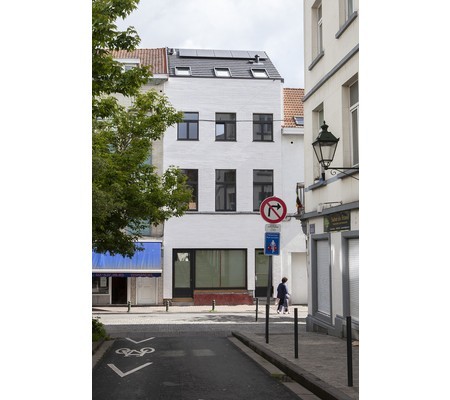Claude Bernard ecodistrict, Paris
Last modified by the author on 23/06/2016 - 10:51
Urban renewal
-
14 ha -
160 000 000 €
The presence of these large infrastructure and programmatic desired wealth for the district imposed a renewed reflection on the density and compactness. Office buildings (40,000 m² divided into three buildings) just as well be a sound barrier for residential buildings, located further back from the ring road.
These four mixed pads accommodation and activities (40,000 m² in total), opening on Boulevard Macdonald, are distinguished by their extreme compactness, which creates a real functional diversity within each building (housing, a nursing home and activities can and superimposed in layers). Formal solutions help to open up these pads by multiplying the views of the gardens and the island hearts. Special care has been taken in the composition of the building feet, essential spaces for the social life of the future district, with the creation of artisanal or commercial premises.
ZAC Claude Bernard is also in discussion with a comprehensive environmental compliance plan objectives climate of the City of Paris. This quickly became a testing ground with the use of deep geothermal energy or the creation of a "linear forest" along the peripheral.
- Operation with the winner Macdonald warehouses of the call for regional projects New urban neighborhoods (NQU) in 2010
Programme
- Housing
- Offices
- Businesses and services
- Public facilities and infrastructure
- Public spaces
- Green spaces
Project progress
- Delivery phase
- Operational phase
Procedure type
- Urban développement permit
Key points
- Governance
- Quality of life
- Mobility
- Energy /Climate
Approaches used
- Ecodistrict national label
- Agenda 21
- Local charter
Certifications
- Ecodistrict national label
More info
http://www.ekopolis.fr/ressources/zac-claude-bernard-a-paris-19eme-retour-dexperienceData reliability
3rd part certified
Type of territory
The ZAC Claude Bernard site
ZAC is located on the former wasteland Claude Bernard hospital, destroyed in 1992. The 14.6 hectare site is part of the Paris Nord-Est major operation to reclaim the land spanning mutable 200 hectares of the Porte de la Villette at Porte de la Chapelle. This sector is in an environment characterized initially by transport infrastructure (peripheral boulevards of the Marshals, railways stations and the North East and Saint-Denis canal) logistic activities (Calberson Ney and Macdonald warehouses) . It connects areas of habitat and is located near the towns of Saint-Denis, Aubervilliers and Pantin.
Climate zone
[Cfb] Marine Mild Winter, warm summer, no dry season.
More info
http://www.semavip.fr/nos-projets/les-projets-en-cours/claude-bernard/synthese-projetGreen areas, roofs included
20 330 m²
Public spaces area
6 500 m²
Office floor area
40 000 m²
Commercial floor area
1 500 m²
Public facilities floor area
10 000 m²
Housing floor area
34 000 m²
Number of residential units
475
Number of social housing units
237
Green spaces /inhabitant
Public spaces/inhabitant
Total of subsidies
379 € HT
Detail of subsidies
3.79 M € TTC - grant from the Region as winner of the call for projects 2010 NQU
Project holder
Project management
- The project ZAC was designed by urban planner and landscape coordinators of all Paris Northeast.
- BNP Paribas Real Estate is the main operator, offices host a group subsidiary.
- The architects were chosen by audition and workshops associated with the project owner.
- An AMO worked on the environmental aspects of each operation in support of the ISO 14001 approach Semavip.
- There are no significant approach to resident involvement.
Project stakeholders
SEMAVIP
Environmental consultancy agency
Chosen as developer of Claude-Bernard ZAC by consultation as part of a concession treaty. Founded in 1985, Semavip is today, with six major development projects, a key joint venture companies of the City of Paris. His first ambition is to translate the daily goals of urban policy of the City of Paris: - improving the living environment, - developing a diverse supply of housing, - reduce slums, - reduce regional inequalities, - re -dynamiser the economy of districts - innovate in terms of sustainable development and architectural creativity.
12 passage Susan Sontag CS 10034 75927 Paris Cedex 19 Téléphone : 01 53 26 87 00

Agency François Leclercq
Assistance to the contracting authority
Blueprint> Urban Project management> ZAC Architect> Operational Monitoring
39, Rue du Repos, 75020 Paris 01 44 61 82 82 http://www.francoisleclercq.fr/
CapTerre
Assistance to the contracting authority
Consultancy - AMO environment
SOLUTIONS
Quality of life / density
- The location of the project makes it a priority site for the densification SDRIF. GPRU sector, it focuses on issues of improvement of the living environment and links with neighboring municipalities.
- The challenge of the work of the planner and coordinator teams of architects was to insert the density of programs, including housing desired by the City of Paris within the limits imposed by the PLU.
- The BIA has a SOC 3 (corresponding to the PLU). The operation is fairly dense, the work of the planner and architects has been to organize the provision of programs to ensure the comfort of the inhabitants, assets and users. The idea was not to make enclosed islands and closed courses, but leave multiple views between the buildings, the air, the light and the way.
- To achieve the desired density by the City of Paris (which has revised upwards its targets for housing from being fed ZAC), while respecting the limitations imposed by the 31 m PLU, it was necessary inventing specific typologies. The work of the architects was to find the best organization, given the thickness of the pads of housing (28 x 43 m). This made the delicate design: depending on lots, homes are organized around a skylight, an interior courtyard.
Net density
Social diversity
- Claude-Bernard on the sector, the PLU of the City of Paris imposes 50% of social rental. 49% of the 477 units are under agreement (including 5% in PLAI, PLUS 20% and 25% in PLS), 25% are controlled rent and 26% self accession.
- Project stakeholders wanted the mix is as generational: a school of 12 classrooms was completed and includes the ground floor a nursery; Quai de la Charente, a creche 66 cribs. Finally a nursing home 104 rooms is integrated into the plot B.
Ambient air quality and health
- Pre acoustic studies showed strong site exposure to noise, primarily due to ring road. The buildings are arranged and oriented to protect housing programs for office buildings.
- On the device, a noise barrier wall will insulate buildings, linear forest reinforcing its effects. Quai de la Charente, a gable wall will isolate the frame of the beam's railways.
-
The operation is primarily exposed to the pollution associated with the proximity to the ring road. Organizational and program orientation, performance glazing and noise barriers were effective in controlling these risks.
Functional diversity
- ZAC Claude Bernard comprises 40% of housing surfaces, according to the PLU. On this, the mix of functions is designed to block or even that of the building. This choice has led to a result of joint programs of work to ensure the architectural and urban coherence overall.
- The functional diversity has been the subject of extensive work between the architect teams, planner coordinator and project management, in particular to enable the establishment of common views through court agreements.
- On a lot, the vertical mixing was pushed to integrate in the same building a nursing home and housing.
- The outdoor areas, they are not mixed use
-
The installation of 6500m2 floor area of the ground floor shops initiates Boulevard renewal that found its completion with shops of Entre Pots Macdonald in 2014
- The integration clauses were pushed to 15% of a share of the operation
- The vast social and functional diversity (variety of housing, creation of offices, shops feet of buildings, leisure center), creating North / South links along with the development of exceptional transport offer (Rosa Parks station, tram T3 ...) transform this area into an attractive and lively.
% of public spaces
% of office area
% of commercial area
Mobility strategy
- The accessibility by public transport is a key issue for the ZAC, served in a radius of 500 m by metro, tram since late 2012, the RER 2015. A full soft traffic network this device, along boulevards, and banks in connection with Aubervilliers and the shopping center.
- A partial mutualisation of parking outside homes, the economy has allowed 40% of seats.
- Partial mutualisation parking saving 40% of parking spaces.
Water management
- The infiltration is made impossible by the gypsum subsoil, water management on the site are mainly axis on the regulation of leakage rates over a significant area of green roofs (3 668m2) and buried the valley of the linear forest .
Waste management
- The aim was, on this, to limit cuts and evacuation. The site requires no backfill, construction waste could be reused on site. But the operation has taken advantage of the proximity of infrastructure: 88% of excavation materials were evacuated by river.
Biodiversity and natural areas
In terms of green spaces, a special effort is being made to change the site of the environmental context. The project includes:
- The implementation of a "green corridor" favorable to the development of fauna and flora.
- The reclassification of the Saint-Denis canal banks for about two kilometers of the Paris area, in coordination with the projects developed by the towns of Aubervilliers and Saint-Denis.
- The creation of a natural reserve of approximately 8000 m2 installed north of the device, along the canal.
SOLUTIONS
- Management of natural areas
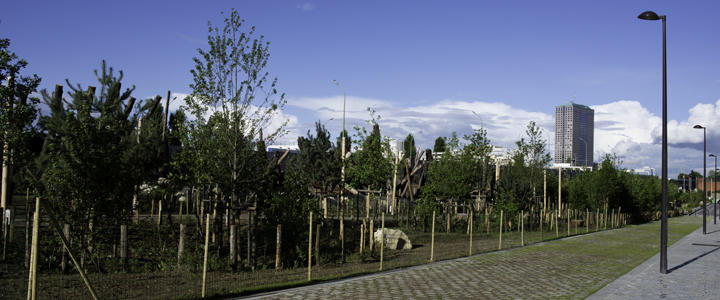
Linear Forest
This linear forest with an average width of about 30 meters, which aims to protect the site will be a nuisance mainly landscaped area open to gentle circulation patterns in conjunction with the banks of the canal.
Climate adaptation, resources conservation, GHG emissions
- ZAC is supplied for heating and cooling, by the urban heating network in the Paris District Heating Company and Climespace network charge on part of Paris of the cold distribution. This system has been awarded the innovation prize in the days of Geothermal Energy in 2012.
- The specifications of environmental requirements require coverage of needs by renewable energy minimum 25% for all programs. In addition to geothermal, photovoltaic panels were installed on three lots of offices (380 m2 in total) and the school (about 120 m2). The buildings, except cinema and school, are equipped with thermal solar panels (300 m2 in total). Overall, 42.5% of the buildings energy needs are provided by renewable energy.
- The whole program was the subject of a monitoring process with a BBC label for dwellings and HQE for offices.
Energy sobriety
- ZAC is supplied for heating and cooling, by the urban heating network, enabling savings of approximately 10,000 tons of CO2 per year.
- Reduction of at least 20% on average energy consumption in reference to thermal regulations RT 2005. The equipment (school, nursery) benefit from an even greater efforts with a reduction of 40-50% and tend toward self energy sufficiency.
- The percentage of renewable energies (ENR) is at least 25% for all buildings.
- Housing transactions reached the BBC label and were the first programs in Paris with this level of performance.
Energy mix
- 42.5% of the buildings energy needs will be provided by renewable energy.
- Geothermal district heating network
- 500 m2 of photovoltaic panels
- 300 m2 panels Solarthermie
Total electricity needs of the project area /year
65,00 kWh
Total electricity production of the project area /year
27,30 kWh
SOLUTIONS
- The entire district Claude Bernard and some neighboring areas as well Macdonald district are powered by a geothermal system.
- Operating a geothermal doublet taking the water to about 55 ° C in the web Dogger to 1600 m depth.
- Innovation Award in the days of the Geothermal Energy 2012
- Renewable energies
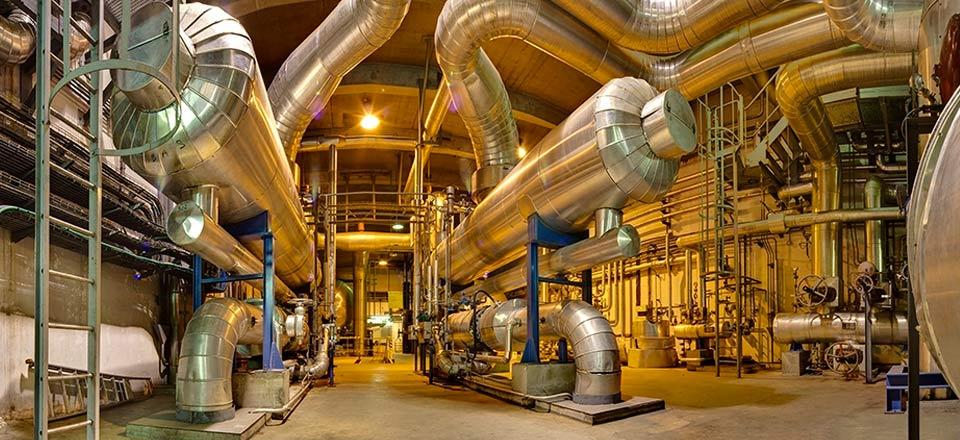
Deep geothermal
As part of the Great Urban Renewal Project (GPRU) of Paris North East area, 103,000 m² of housing, offices, equipment and business premises will be connected to the distribution network of hot Paris for a North East 5 MW.
CPCU and Climespace are part of this project and innovate by building an underground thermofrigorifique whole plant with a capacity of over 100 MW, powered by a geothermal doublet. This will produce both a geothermal hot or cold through the thermo-refrigerator-pumps, which system the heat is also recovered in the hot network.
The eco-neighborhood
10 000,00 tCO2
http://www.cpcu.fr/ra2010.pdf
Buildings
High Environmental Quality buildings
Accommodation is certified with the certificate BBC Habitat & Environment A1 Performance2 profile option (Cerqual). The offices have tertiary HQE certification (Certivéa)
It is required builders to obtain stringent certifications and management of low nuisance sites:
- NF tertiary buildings (HQE for consumers services and education)
- Cerqual and H & E (housing).
The preferred targets are managing energy, acoustic comfort, health air quality, water management and integrated choice of construction processes and products. The "performers" levels or "high performance" is required.
The buildings are designed to be safe through the use of materials not releasing any harmful health product.
The management of projects is also part of the project with the limitation of noise, cleanliness, waste sorting, reducing the duration of the works ...




